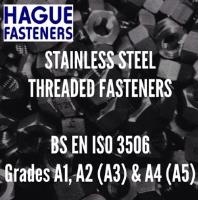 Add My Company
Add My Company
Sign In

General grades of Stainless steel fasteners are specified in BS EN ISO 3506
Part 1 covers bolts, screws & studs
Part 2 covers nuts
These specifications replace BS6105, which is withdrawn as a British Standard.
Chemical Compositions
The chemical compositions of austenitic stainless steel fasteners with the designations A1, A2 & A4 are shown in table 1. (These designations are common for the different parts of BSENISO 3506. The composition ranges are based on part 1. The table shows some of the grade designations, which have been used, in other British Standards
Table 1 – Chemical Compositions for Austenitic Stainless Steel Fasteners
Grade
Chemical Composition (% maxima unless stated)
20140225-232736.jpg
Notes
Either sulphur or selenium (less common) is allowed in grade A1.
These additions make the steel free machining for ease of manufacture but can reduce the corrosion resistance under certain conditions such as marine environments (chloride pitting attack risk)
Grade A2 does not specify molybdenum additions but allows these (Normally the deliberate addition of molybdenum makes the grade A4).
The carbon level of grade A4 is allowed to be up to 0.12% max. to obtain specified mechanical properties at larger diameters.
The less common grades A3 & A5 are included in the standard and are based on the A2 & A4 grades respectively. These have additions of either titanium or niobium/tantalum to form ‘stabilized’ grades and can be used as alternatives to A2 or A4 grades, with carbon levels restricted to 0.03% max, in applications where there may be a risk of intergranular corrosion.
Hague Fasteners excel in these less common “stabilised” fastener grades and are one of very few UK manufacturers that carry stocks of Grade A5 class 80 (A5-80) bar material for production of special stainless threaded fasteners.
The standards also refer to a duplex composition as steel group “FA” (ferritic-austenitic) in their informative annex sections. This grade (similar to a 1.4462, 2205 of EN 10088-1) is
not currently included in BS EN ISO 3506 but is likely to be included in the future, the standard suggests.
Mechanical Properties
Three “property classes” are assigned to each of the austenitic stainless steel fastener grades in parts 1 and 2 of BS EN ISO 3506. Table 2 shows the 0.2% proof stress, tensile strength and elongation values for each of these property classes for the austenitic stainless steel bolts, screws, studs and nuts.
Table 2 – Mechanical Properties for A1, A2 and A4 Austenitic Stainless Steel Bolts, Screws, Studs and Nuts (BS EN ISO 3506 Parts 1 & 2)
20140225-233110.jpg
Notes
The mechanical property limits are minima.
Property class 50 represents the steel in the annealed condition.
The most common & readily available supply condition is property class 70, which represents a “cold drawn” for the bar stock from which the fasteners are made.
Property class 80 is based on severely hard cold drawn bar.
All tensile stress values are calculated and reported in terms of the nominal tensile stress area of the thread.
The elongation measurement is determined on the actual bolt or screw length and not on a prepared test piece. This is expressed in millimetres (mm) of extension and not as a percentage elongation.
i.e. A = (L2 – L1) (where L1 = original length and L2 = length after fracture) d = nominal diameter of bolt, screw or stud.
Hague Fasteners are not concerned with the tonnes of Far Eastern, uncertified, imported A2 & A4 commercially available standard bolts and nuts. Hague Fasteners forte is the specialist manufacture of bolting components in Quality Assured EU sourced raw materials particularly in the higher property classes, A2-70, A2-80, A4-70, A4-80, A5-70, A5-80
For more information on Stainless Steel Fasteners to BS EN ISO 3506 Grades A1, A2 (A3) & A4 (A5) talk to Hague Special Fasteners Limited
Enquire Now
More News
List your company on FindTheNeedle.

